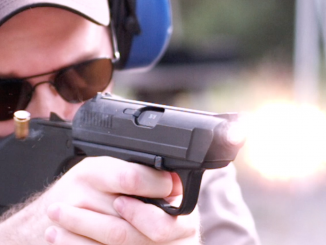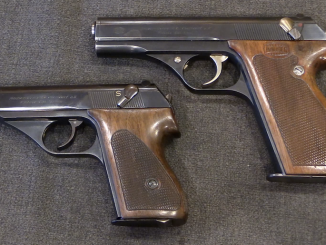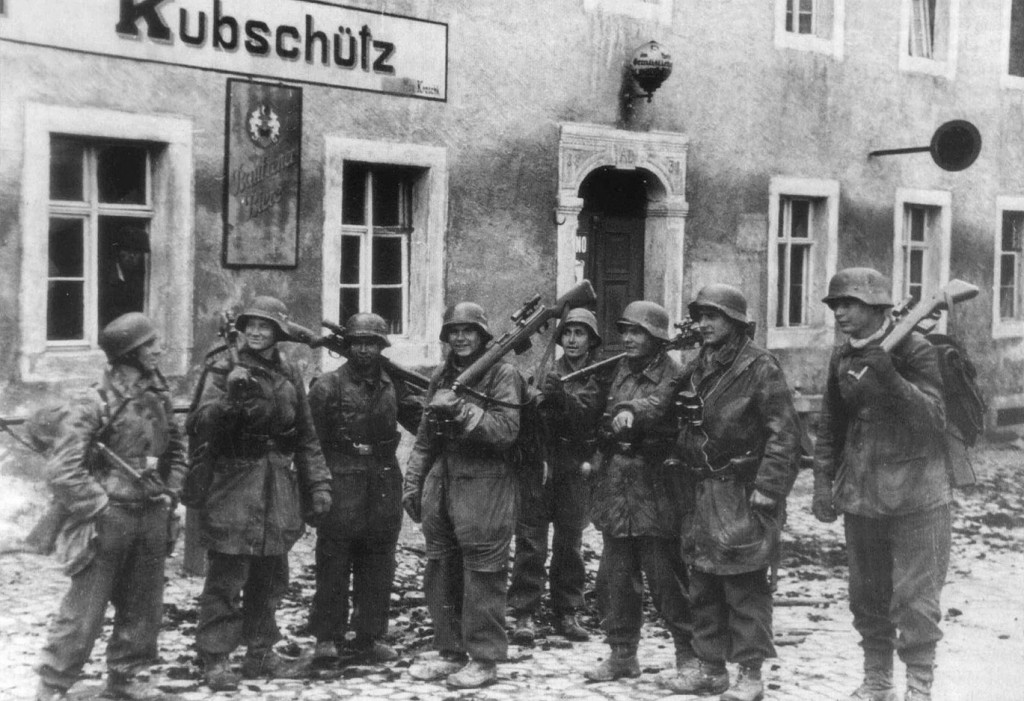German snipers of the Hermann Goering Division in Bautzen, 1945. Most have scoped G43 rifles, but the man at the far left has an MP41 (and a paratrooper helmet) and the third man from the right appears to have a scoped Mosin Nagant.
Related Articles

Machine pistol
H&K VP-70M on the Range: How Useful is the Burst Fire?
After looking at the history and mechanics of the VP-70 yesterday, we are heading out to the range to try it out (and thanks to Trijicon for generously offering use of their range!). I am […]

Bolt Action Rifles
German Mauser Obrez Pistol
From the collection of the Deutsches Historisches Museum, a reader named James found an example of an Obrez pistol made on a Mauser K98 rifle action. This apparently was made by Czech partisans during World […]

Prototype
Prototype Locked-Breech 9x19mm Mauser HSc
When Mauser began development of the HSc pistol, it was intended to be a pair of guns – a simple blowback gun in .32 or .380 caliber for civilian and police use and a larger […]


* For the paratroper that’s Could be an Beretta M1938/44 instead of MP41 with the slot compensator at the front.
* The Mosin Nagant sound luke have a PE or PEM scope
I’d have to agree about the chance it is probably a Beretta SMG.
That one could be a Nagant, but might also be an old GEW88 taken out of storage and pressed into service. Can’t see enough of the gun to make any more than a wild guess.
I’m inclined to agree with snmp — it looks like a Mosin-Nagant with a PEM scope.
Were Gew88 rifles ever scoped? I have never heard of or seen reference to that. The scope and mount certainly seem Moisin-like.
It’s a Mosin 91/30 with a 3.5x PU scope. The scope does not look like the long body PE/PEM versions. The mount is also a PU type mount.
* Forgot to add, the spacing between the rings on the scope/mount is too close to be a side rail PEM.
Dan91, spot on ID of the sniper. No matter what spacing of the ring, though – the scope mount has a square slab with round hole, while the PEM offside mount was the wide V with two separate supports for rings. This is 100% Mosin sniper of late variation with PU scope.
And the SMG is most definitely an early Beretta 38/42 with bull barrel.
Looks like at least 5 have the paratrooper smock. While only one has the specialized helmet, they mostly fought as line infantry late in the war anyway, so most of them probably didn’t need a rimless helmet as they weren’t exiting any aircraft anyway.
This might be of interest to some here. WWII German Sniper Training Course. It has been translated to English. It’s an hour long and IMO better then watching most TV or Hollywood movies.
http://www.milsurps.com/showthread.php?t=820
A very informative training archive from an excellent web site — thanks for sharing, Martin!
I watched it (video) nearly to the end; it is learning piece of information. I shows (allowing for fact it is training movie) that the anticipated engagements for what we call now “designated marksmen” are just in couple hundred of meters. It also suggests that even in age of fighting on the move as WWII was, there was plenty of opportunity to be involved in static fighting.
The quality snipers were on both and all sides. Movies rarely shows Uzbek or Kazakh snipers, yet they were among the best on Soviet side. Their talent in seeing far was notable and attributed to their life as herdsmen – they were able to see and count their livestock in steppe at long distances. Yes, the weapons are important, but the operator’s abilities equally so.
@ Dan91 :
I think you’re right — I took another look under higher magnification and it does appear to be a PU scope set-up, not a PE or PEM. Good catch!
the first guy on the left has a submachinegun any idea’s? dosent look like an mp-40 or similar. he also has a rifle sung across his back.
No shoped Gv 88 has yet surfaced.one with a diopter has been seen. Shoped german military rifles apeared in the first part of !. WW.the first were hunting rifles reqisioned by the army
What’s with the guy 2nd from right – his right arm is posed as though resting on a rifle – but no rifle is to be seen?
@Bryan, Dimitris:
Look behind the guy’s back, on the level with top of his pistol holster – the parallel grey line seems to be a part of the wooden stock, the darker triangle on top of it is part of the sling entering the side slot in the stock, which indicates a rifle, not a machine gun, Dimitris. Anyway, the MG-Schuetze would have a spare parts wallet on his belt, not the NCO field bag. One more interesting detail – this is one of ca. dozen photos I have ever seen of German troops wearing a pistol lanyard, draped around this guy’s neck.
Bryan, this is the clasic pose for the MG’s, MG34 or MG42.
‘Knaben’ are smiling… I wonder what makes them to. Because they will be soon surrendering to Russians (Bautzen in in East Germany though)?
Actually, from seeing many pictures (used to have stack od Die Wehrmacht weekly magazines with lavish photo-reports from fronts over in Europe) I always admired their morale. If you are couched to think they were all wrong you must start to question where the truth was. Either way, they had high morale all they way to the end and even (and so much more) after. Many of them who were taken POWs and shipped to either States or Canada, have later become citizens here. Like I say, the German boys must be true optimists.
It certainly says a lot about the unique quality of their survival at a time when almost every man’s hand ( and opinion ), and the odds, were stacked against them. As a singular representative example, just look at the history of the surviving Luftwaffe aces. One has to at least respect that, even if one disagrees otherwise.
In truth, as in life, nothing is ever black or white, contrary to what friendly or hostile propaganda would have us believe. Who was it who said that the victors always get to write history as they see fit ( and for their own purposes )?
That’s correct, Earl. There is something I like to call ‘tribal togetherness’. I works, regardless of ideologies or concept such as wright-wrong; and it works always.
It leads me to pick just randomly, notoriously known piece from Das Boot – the German submariners in nearly hopeless situation singing “Long way to Tipperary”…. true, it is in movie, still amazing.
I agree. Das Boot is about as humanly and technically realistic as it is possible to get. Variations of the “It’s A Long Way From Tipperary” episode in Das Boot, which would have been regarded by the Gestapo ( or any of the powers that be on either side ) as treasonous, occurred among Axis and Allied servicemen of all stripes far more frequently than is acknowledged, even today. It only goes to show that the vast majority actually did not have anything tangible against the fellows from the other side beyond the vilification that had been stirred up by the propaganda machine, often with the utterly distasteful use of racist stereotypes.
It has been said by more than one soldier, sailor or airman that there was more respect and, ultimately, more empathy, for the enemy among the ranks than for their own leaders and the smug non-combatants they were supposedly fighting for who profited from the war. This is not to say that the need to defeat expansionist Fascism was not absolutely necessary at the time ( it was, given the forced circumstances ) ; just that the human price that was paid for the vainglorious ambitions and idealisms of a minority was impossibly enormous.
Earl, as always, great chatting with you and as (almost) always, cannot help it to deviate from main subject. I think we ought to say “respect” to the Editor for his generosity!
@ Denny :
You’re absolutely right. Apologies for getting a little carried away. And with utmost respect to Ian as well as all other contributors for their understanding and forebearance. Thanks!
Not likely true optimists at all. In both the Teutonic and Celtic cultures there is thing about fighting against long odds. And don’t really consider not beating something more powerful is losing.
I consider your view Martin. You may also want to read what Randall and Earl think about it. Quote from Remargue by Earl captures the essence of it.
In my own observation, there are similarities and substantial differencies between both cultures. I can certainly, as ex-neighbour to Germans talk of their part.
A couple of considerations:
1. If that’s an OFFICIAL photograph, they had a VERY real incentive to look “motivated”. At the end of the war, SS units were wandering around semi-randomly executing “deserters”, “defeatists”, etc., including civilians who put out white flags in anticipation of Allied occupation.
2. With good reason, NOBODY wanted to get captured by the Soviets. They might have been personally unmotivated by the Nazi cause, but they had EVERY reason to keep fighting, if for no other reason to reach American or British lines.
Yes, PU scoped MN is correct. The second and third soldaten from the left have standard K98k sniper rifles though (high turret?). The bolts on both can be seen, and the take down disc on the fourth man as well. Can’t see the weapons on the second and fourth from the right.
Make that the second and third from the left with the Mausers. Totally agree with the comment on morale. Smiles here must have involved dark humor indeed.
@ Randall :
Very good observations about the Kar 98k rifles.
And what was that line from Erich Maria Remarque’s “All Quiet On The Western Front” — “…we are in a good humour because otherwise we should go to pieces. If it were not so, we could not hold out much longer ; our humour becomes more bitter every month”. It was still relevant all those years later during World War Two, and will, I suspect, always be so under similar circumstances.
http://en.wikipedia.org/wiki/Battle_of_Bautzen_(1945)